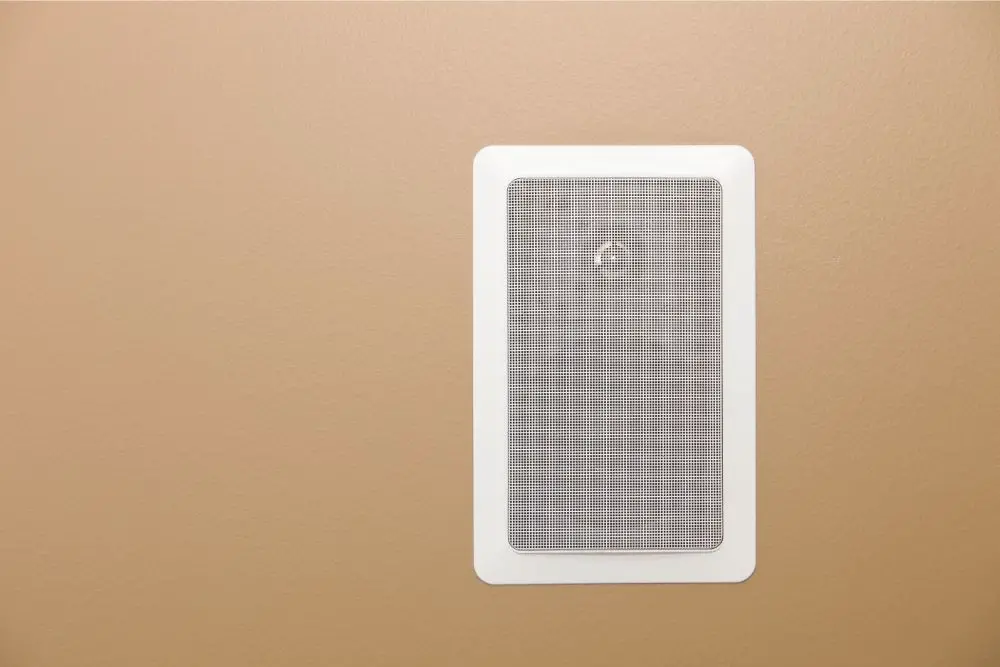Can in-wall speakers sound good?
Yes, they can help to create a more immersive sound experience overall.
They can be mounted directly into a wall and can be incorporated into any surround sound setup and creates much more spatially accurate sound reproduction.
They are an excellent solution for small spaces because they take up no floor space in the room. They are also useful if you are tired of constantly having to untangle regular speaker wires.
As they are specifically designed to be mounted straight into the walls of your home or office, this means that there needs to be a big enough hole in the wall for it to fit into. Cutting into a wall can be risky, but many in-wall speakers include a useful template to trace around before cutting.

In-wall speakers must be placed on drywall or false walls, and you must be familiar with the location of load-bearing supports, pipelines, and other electrical wirings in your home. They are budget-friendly and easy to install.
They are suitable for home cinema speakers and used for rear-end surround sound, because of their low price it is easy to make a home cinema with in-wall speakers.
Although in-wall speakers are typically cheap, this does not stop them from producing high-quality music with bass. They work great, and if you choose the proper speakers for your room, you will definitely appreciate the sound.
In large spaces, in-wall speakers may transmit sound across the space while also bridging the gap between rooms, which is perfect for entertaining. Consider installing in-wall speakers throughout the main living area, kitchen, and dining room to provide you and your visitors with a large-area sound experience.
In-wall speakers are normally 8 inches in size, whereas most in-ceiling speakers are 6.5 inches. Because they are larger, location is critical. You don't want their size to detract from the atmosphere of your room.
Are ceiling speakers better than wall speakers?
The answer will depend on what you want out of your speakers. In-ceiling speakers are typically circular-shaped speakers designed to nestle into your ceiling.
Ceilings are excellent locations for speakers since they are out of sight and provide an additional dimension of sound. They’re typically inexpensive and can be bought for less than fifty dollars without having to compromise too much on sound quality.
Ceiling speakers can be installed in just one room or all throughout the house. They can be used to create flowing, fluid sound in multiple rooms, such as background music at a large party. If you enjoy entertaining, you'll like the versatile, subtle surround sound experience they deliver both indoors and out. They're pretty to look at, but they're not always visible anyway.
They usually blend in well with the overall appearance and feel of your space and rooms. home. As a result, they are a very visually pleasing solution.
Choosing between in-ceiling speakers and in-wall speakers should be determined by your needs and budget. Each has its own advantages and disadvantages, but they perform and function differently.
In-ceiling speakers are a terrific way to add extra dimension and reach to your sound system at a minimal cost. You'll appreciate the versatility, small size, and additional sound dimension.
In-wall speakers are a wonderful option if you want to generate a loud, multi-dimensional sound, but you should expect to be prepared to pay a little more for it. The huge size produces a powerful, wide-area sound, while still allowing for some placement flexibility. You can always be creative in how you hide or distract visitor's attention away from them.
Are in-wall speakers as good as bookshelf?
In-wall speakers are powerful and can be mounted on any wall; however, in-wall speakers that produce the same or similar sound quality as bookshelf speakers will cost two to three times as much.
Bookshelf speakers are more appealing, offer higher sound quality, are more flexible in placement, and are less expensive, but they are larger and are not ideal for big areas.
If you are trying to pick between the two, it is critical that you understand what distinguishes them, the benefits they bring, how best to utilize them, and take into account other elements such as space, the aesthetics of the two, and other considerations.
Bookshelf speakers, also known as bookshelf loudspeakers, can be installed as standalone speakers in your living room or as part of a larger home theatre system. If you want to upgrade your home audio system, there are several good bookshelf speakers that you can use in your space.
Bookshelf loudspeakers are built with enclosures that limit the rear reflection of sound, causing it to collide with the front and result in sound cancellation. These enclosures also keep the drivers cool as they work.
If you want to upgrade your home theatre system at a lower rate for higher sound quality, you might lean towards bookshelf speakers because they provide more sound at a cheaper price, are adaptable, but are best suited for small to medium rooms unless they are linked to larger systems.
On the other hand, if you're not concerned about large spaces being covered entirely by the sound, want more placement options, have your speakers out of sight, and so on, you should spend a little more money on high-quality in-wall speakers that will draw attention away from them while still delivering superb sound. However, in-wall speakers are not appropriate for rented buildings such as flats or condos that you do not own.
If you really want to fit in-wall speakers, it is strongly advised that you get permission from the property owner first. Another issue to consider is sound polluting neighboring rooms or homes, which can lead to hostility.
